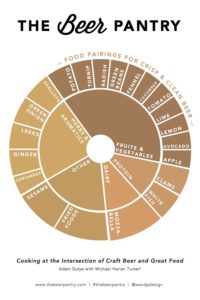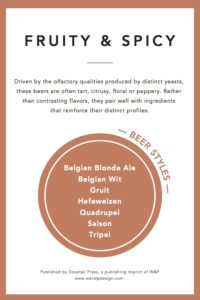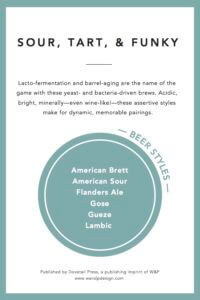
In our brave (and relatively) new craft beer world, brews have become more than just a way to wash something else down.
In their new cookbook The Beer Pantry: Cooking at the Intersection of Craft Beer and Great Food, Adam Dulye, executive chef to the Brewers Association, and Michael Harlan Turkell share the art of beer pairing for us home cooks. Going beyond the beer’s role as a novelty recipe ingredient (beer can chicken, anyone?), Dulye breaks down the qualities of beer while suggesting optimal flavor pairings and sharing recipes that use beer as a central, featured ingredient.
Recognizing the diversity and complexity of craft beers on the market nowadays, the book prioritizes the specific flavor profile of various brews (crisp, bitter, tart and so on) to make pairings. “Crisp & Clean” beers, for example, are said to pair best with dishes that have a “bright note, light salt or vegetable flavor” and use their gentle carbonation to cleanse the palate of light fats like olive oil. The book recommends “Fruity & Spicy” beers for rich dishes that have a similar flavor profile, like meats accented with fruit and strong seasonings.
Beer Pantry includes specific tips for identifying flavor notes, too, including a guide to tasting that advises beer geeks to observe the color, aroma, carbonation and palate/body of a brew. Each recipe also includes a suggestion of a few specific craft beers from breweries around the country, most of which can be found at your nearest bodega.
For pairing with the citrusy hops of Brooklyn Brewery’s Brooklyn Sorachi Ace, Dulye and Turkell share this Mediterranean-inspired halibut recipe:

Olive Oil-Poached Halibut with Fennel, Green Olives and Lemon
Makes 4 servings
4 cups olive oil
Kosher salt
Freshly ground black pepper
8 garlic cloves, smashed
3 fennel bulbs, halved, cored, and cut into ¼-inch-thick wedges, fronds reserved
1 teaspoon fennel seeds
1 teaspoon granulated sugar
1 bay leaf
Strips of zest from 1 orange
Strips of zest and juice from 2 lemons
4 six-ounce skinless halibut fillets, about 1½ to 2 inches thick
2 tablespoons finely chopped chives
2 tablespoons finely chopped parsley or chervil
2 tablespoons finely chopped tarragon
½ cup Castelvetrano olives, pitted and halved
Place the oil in a 5- to 6-quart heavy-bottomed pot and warm over medium heat until an inserted instant-read thermometer reads between 180° to 200°F (the oil should gently bubble). Season the oil with ¼ teaspoon each salt and pepper and add the garlic, fennel wedges, fennel seeds, sugar, bay leaf, and orange and lemon zests. Gently simmer until the fennel is tender, about 30 minutes. Using a slotted spoon, transfer the fennel, garlic, bay leaf and zest to a bowl.
Return the oil to 180° to 200°. Season the halibut with salt, add to the oil, and cook on one side only until opaque, 7 to 10 minutes. Carefully transfer the fish to a plate, cover with parchment, and let rest for 5 minutes.
Reheat the fennel mixture in a skillet over low heat, then discard the bay leaf. Divide the vegetables and halibut among 4 plates. In a bowl, mix the chopped herbs, olives and lemon juice with ¼ cup of the poaching oil. Spoon over the top of the fish and vegetables. Garnish with the fennel fronds and serve.
Recipe courtesy of Dovetail Press.
SaveSave
SaveSaveSaveSave
SaveSave
SaveSave
SaveSave
SaveSaveSaveSave
SaveSave
SaveSave
SaveSave
SaveSave
SaveSaveSaveSave
SaveSave
SaveSave
SaveSave
SaveSave
SaveSave















